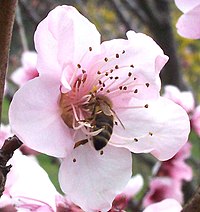
Photo from wikipedia
AimsWe studied the effects of Phacelia tanacetifolia, increasingly used as a cover-crop species in arable agricultural systems, upon soil structural properties in the context of two contrasting soil textures. We… Click to show full abstract
AimsWe studied the effects of Phacelia tanacetifolia, increasingly used as a cover-crop species in arable agricultural systems, upon soil structural properties in the context of two contrasting soil textures. We hypothesised there would be differential effects of the plants upon soil structure contingent on the texture.MethodsA sandy-loam and a clay soil were destructured by passing through 2 mm sieves, and planted with Phacelia in a replicated pot experiment, with associated unplanted controls. X-ray Computed Tomography was used to visualise and quantify the soil pore networks in 3D.ResultsFor the sandy-loam soil, there was no impact of plants upon aggregate size distribution porosity, pore connectivity, and pore surface density decreased in the presence of plants, whereas for the clay, there was a significant increase of aggregates <1000 μm, the porosity was constant, the pore-connectivity decreased, and surface density increased in the presence of plants.ConclusionsPlants can impact the structural genesis of soil depending on its inherent textural characteristics, leading to a differential development of pore architecture in different contexts. These results have implications both from an ecological perspective and in terms of the prescription of plants to remediate or condition soil structure in managed systems.
Journal Title: Plant and Soil
Year Published: 2019
Link to full text (if available)
Share on Social Media: Sign Up to like & get
recommendations!